Coronary - CCT
Coronary - CCT
Coronary - CCT
- No tags were found...
Create successful ePaper yourself
Turn your PDF publications into a flip-book with our unique Google optimized e-Paper software.
Japanese Bifurcation Club@<strong>CCT</strong>Coordinators: Yutaka Hikichi, Yoshihisa Kinoshita,Yoshinobu MurasatoFriday, January 29 10:30-12:30 Room 10<strong>Coronary</strong> bifurcation lesions are frequently encountered and theyremain a very challenging issue even in this era of drug-eluting stent.It is necessary to understand the basic nature of the bifurcation inanatomical, physiological, and pathological terms in order to betterunderstand the problems peculiar to the bifurcation. In this session,professional experts in these areas will demonstrate contemporaryinformation and skilled interventional cardiologists will presentfascinating imaging. This session will surely provide you with acomprehensive understanding of bifurcation lesion.See p. 37CTOCC(China CTO Club)@<strong>CCT</strong>Coordinators: Eisyo Kyo, Yong HuoSaturday, January 30 10:30-12:00 Room 11We are trying something new at <strong>CCT</strong> 2010 with the ChineseSession. The purpose is to inform the audience of the current statusof interventional therapy in China. Even with the global recession,China has maintained a high economic growth rate in recent yearsand the standard of medical care for the Chinese people isprogressing rapidly. Remarkable growth has been seen in China’sdomestic medical equipment manufacturing including manyproducts in the field of intervention. This is the first session at <strong>CCT</strong>where simultaneous interpretation will be provided in threelanguages, Japanese, Mandarin Chinese, and English in the hopesthat this will become a place for exchanging ideas between Japan,China, and the World.See p. 40SymposiumState-of-the-art lectures on hot topics:Cutting edge management on contrastinduced nephropathy (CIN)Coordinator: Naoto InoueThursday, January 28 10:00-12:30 Room 3This course will provide an opportunity to obtain the new level of thefollowing CIN management:- Identify percutaneous intervention patients at risk of CIN- Low osmolar vs iso-osmolar contrast media- Pharmacological prevention of CIN- Removal of contrast media- Minimal use of contrast media in PCIEJJWhat you can learn from evidenceCoordinator: Masato NakamuraFriday, January 29 16:30-18:30 Room 3Evidence gained from clinical studies is a proof of a hypothesis, andembodies a universal truth. Regarding this point, evidence based onthe procedure called PCI signifies evidence that transcends disparity inpractitioner skill. Furthermore, clinical studies dictatemany exclusions and therefore, encompass a facet that does notreflect clinical reality. These observations force us to consider thealways important issue of the extent to which clinical study resultsshould be applied in clinical practice. We wish to focus on anddiscuss in this session the current unresolved issues surrounding thequestion of how much the results of recent large clinical studiesshould be incorporated into our clinical practice.See p. 35DES SummitCoordinator: Kazushige KadotaFriday, January 29. 8:30-12:30 Room 6Although the therapeutic benefit of DES has been established, thelong-term outcome reveals the remaining problems. Since variousDESs including next-generation are available now, the appropriateselection of DES and treatment strategy is getting more important.From this point of view, we discuss the latest topics of DES.See p. 35ACS ForumCoordinator: Hirotaka OdaSaturday, January 30 8:30-12:00 Room 10With the advent of DES, restenosis rates have decreased as expected.However, there has not been clear improvement in patient prognosisnor a decrease of myocardial infarction. DES provides local therapy atthe lesion level, however, as long as a comprehensive interventionalstrategy for arteriosclerosis is not undertaken, the beginning of truetherapy cannot be reached. There is an opportunity for those whoperform PCI to implement secondary prevention and, as with PCI, wehave a duty to our patients to do so in an appropriate manner. Here,we will focus on secondary prevention and discuss evidence basedinterventional treatments.See p. 39See p. 317


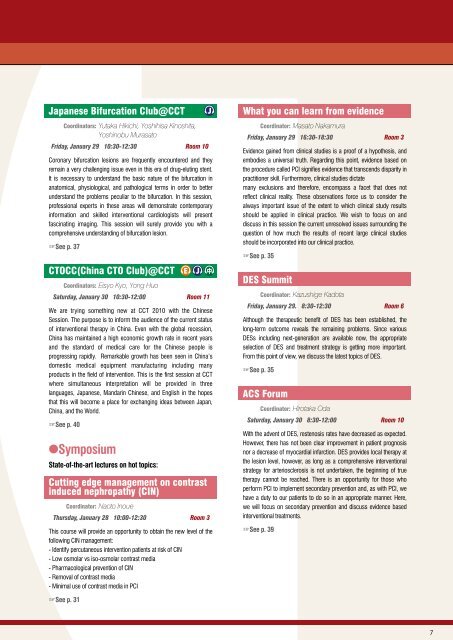
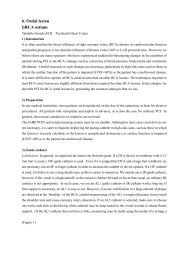
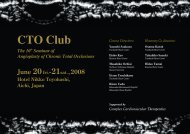
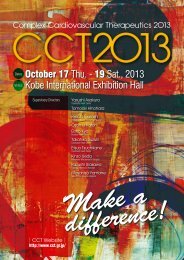



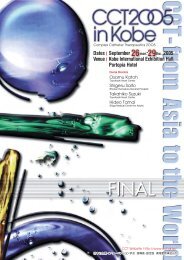



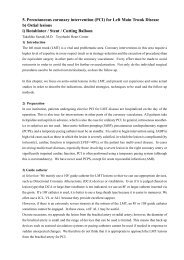
![Program CCT 2004 [PDF: 25MB]](https://img.yumpu.com/28415578/1/184x260/program-cct-2004-pdf-25mb.jpg?quality=85)

